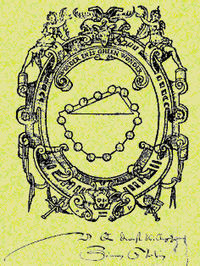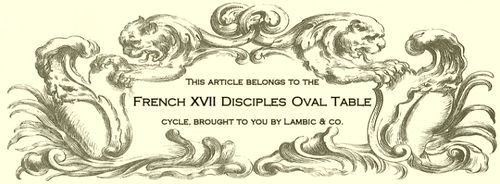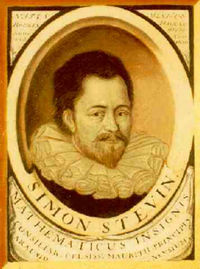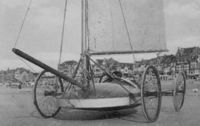Simon Stevin

“Sail along, my silv'ry moon, / with this thing I'll catch you soon.”
“Met Stevin viel er tenminste land te bezeilen.”
– William I "the Silent" of Orange-Nassau
Simon Stevin (Bruges, 1548 – The Hague or Leiden 1620) was a great man, a modern man even, without whom you'd never been staring at the screen of a computer (well, maybe you would, but that would be a fake one). Yes, my dear computer friend! What would you you do, right now, yes you, without decimal commas? OK, if you're American, you'd use a point... But that's not the point: without Stevin's decimal comma (or American point, grrr), you'd still be using fractions. That's the point!
Windy Bruges[edit | edit source]
Gone with the wind[edit | edit source]
Simon liked his daily stroll along the mighty North Sea (which came much closer to Bruges than it does today), but it annoyed him to be pushed by the wind at the start of his promenade, and having to fight against it when going home. Inspired by the sailships at sea and a friendly passing-by Muse, he made a sail to carry with him, so he would be able to sail sharply near the wind, and get home comfortably.
Rolled with the wind[edit | edit source]
Although he wasn't really a clumsy person, he almost broke his neck more than once, and decided to put the sail on a cart, thus inventing the sailcart or "land yacht". Now he almost broke his neck when speeding up to 120 Kmph, but at least, he had achieved something. One of his prototypes, left in a friendly neighbour's shed when leaving for Paris, would be used after his death by the famous Flemish (then still to be) Pirate Jean Bart for his trip from Bruges to Dunkerque.
Flashy Paris[edit | edit source]
The decimal comma[edit | edit source]
Being unable to sit down for a long time, he decided to see what was up in the Cultural Capital of the Europe of that time, and set off to Paris. When he saw the local book printers struggling with those ugly fractions they were being fed by the greatest mathematicians of the time, he decided to help them, and invented the decimal comma.
The American decimal point[edit | edit source]
When a minor French mathematician, called Jean-Baptiste Point à la Ligne, saw the first printings with that comma, he got terribly jealous. He'd never accomplished anything worth printing, and saw he was missing out on a totally new concept that way. So when leaving for America, he took the idea with him, and started his own publishing and printing company over there. No wonder he didn't get anywhere in Paris: he wasn't even capable of remembering the shape of the comma Stevin introduced, and used a point instead. The actual "Muricans" are still stuck with this pointless point that should have been a comma.
The mystery of his death[edit | edit source]
It is said that his place of death is unknown, but insiders know that he died in the very same squalid apartment where Molière was born somewhat later, his parents having moved in right after Stevin's death. So that takes care of that one. Although Molière himself only found out when the XVII Disciples tried to invite the inventor.
How to become a posthumous Disciple[edit | edit source]
When the XVII Disciples invited Simon at their First Convention in 1670, they found out that he was dead. For half a century even. But there was no way to convince Jean Bart of dropping the case: Simon Stevin built the land yacht that let him come to France over land, without feeling a total landlubber, and he felt obliged to the man. Since they couldn't refuse easily something to the youngest and most vigorous Disciple, and they all liked the decimal comma, they finally gave in, and put his portrait on a chair at each Convention.
Disciples' Dessert: Waffles![edit | edit source]
Actually, his portrait wasn't the only object that reminded the Disciples of Stevin. At the end of each meal the Disciples had enjoyed together, Lully made a large pile of waffles, using the recipe Molière's parents found when moving into the apartment where Stevin had spent his last years. They called it "Brussels Waffles", and later on they gained fame as "Belgian Waffles"



